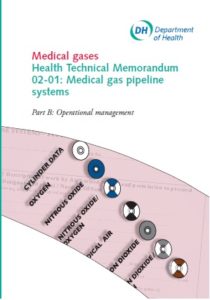Health Technical Memorandum 02-01- Medical gas pipeline systems Part B- Operational management
Health Technical Memorandum 02-01- Medical gas pipeline systems Part B- Operational management
This volume of Health Technical Memorandum 02-01- Medical gas pipeline systems Part B- Operational management looks at issues of operational management. It covers such issues as statutory requirements, functional responsibilities, operational policy, operational procedures, training and communications, cylinder management, general safety, maintenance and risk assessment – control of exposure to anaesthetic agents, giving definitions and working practices throughout.
This volume of Medical gas pipeline systems Operational management Health Technical Memorandum 2022 covers the operational management and maintenance of systems for the supply by pipeline of:
a. medical oxygen,
b. nitrous oxide,
c. nitrous oxide/oxygen mixture (50% v/v),
d. nitric oxide (currently 1000 vpm in nitrogen),
e. medical compressed air for both respirable applications and surgical
tools (at 400 kPa and 700 kPa respectively),
f. oxygen/carbon dioxide mixture (5% CO2),
g. medical vacuum;
h. waste anaesthetic gas scavenging systems (AGSS).
You can also Read Medical Gases Production, Applications and Safety 2015
Health Technical Memorandum 02-01- Medical gas pipeline systems Part B- Operational management
- Executive summary
![Medical gas pipeline systems Medical gas pipeline systems]()
- Scope
- Functional overview
- Statutory requirements
- Functional responsibilities
- Operational policy
- Operational procedures
- Training and communications
- Cylinder management
- General safety and fire precautions
- Maintenance
- Risk assessment – control of exposure to anaesthetic agents
- Appendix I – General safety requirements
- Appendix II – Procedure for breaking into an existing system
- References
- Other publications in this series
- About NHS Estates
A MGPS is installed to provide a safe, convenient and cost effective system for the provision of medical gases to the clinical and nursing staff at the point of use. It reduces the problems associated with the use of gas cylinders such as safety, porterage, storage and noise.The guidance given in this HTM should be followed for all new installations and refurbishment or upgrading of existing installations. It is not necessary to apply the guidance retrospectively unless patient or staff safety would be compromised.


I was recommended this website by my cousin. I’m not sure whether this post is written by him as nobody else know such detailed about my trouble. You are incredible! Thanks!